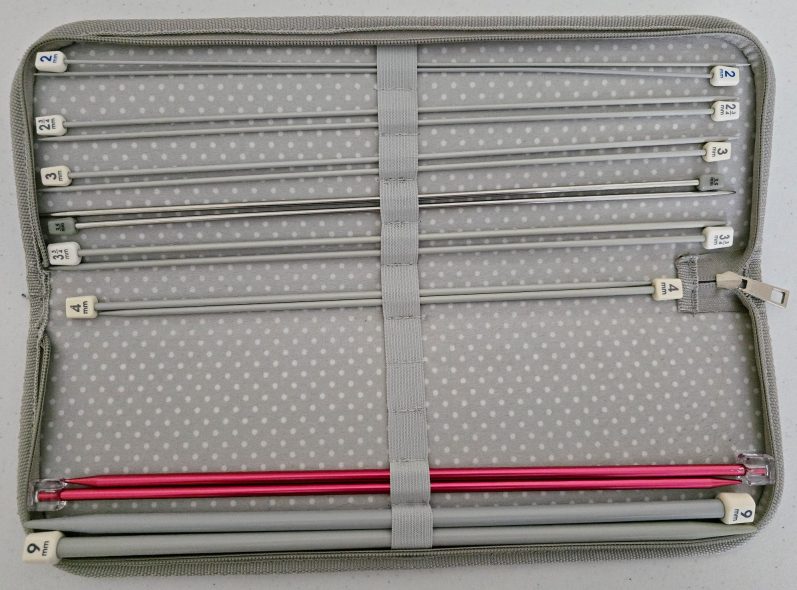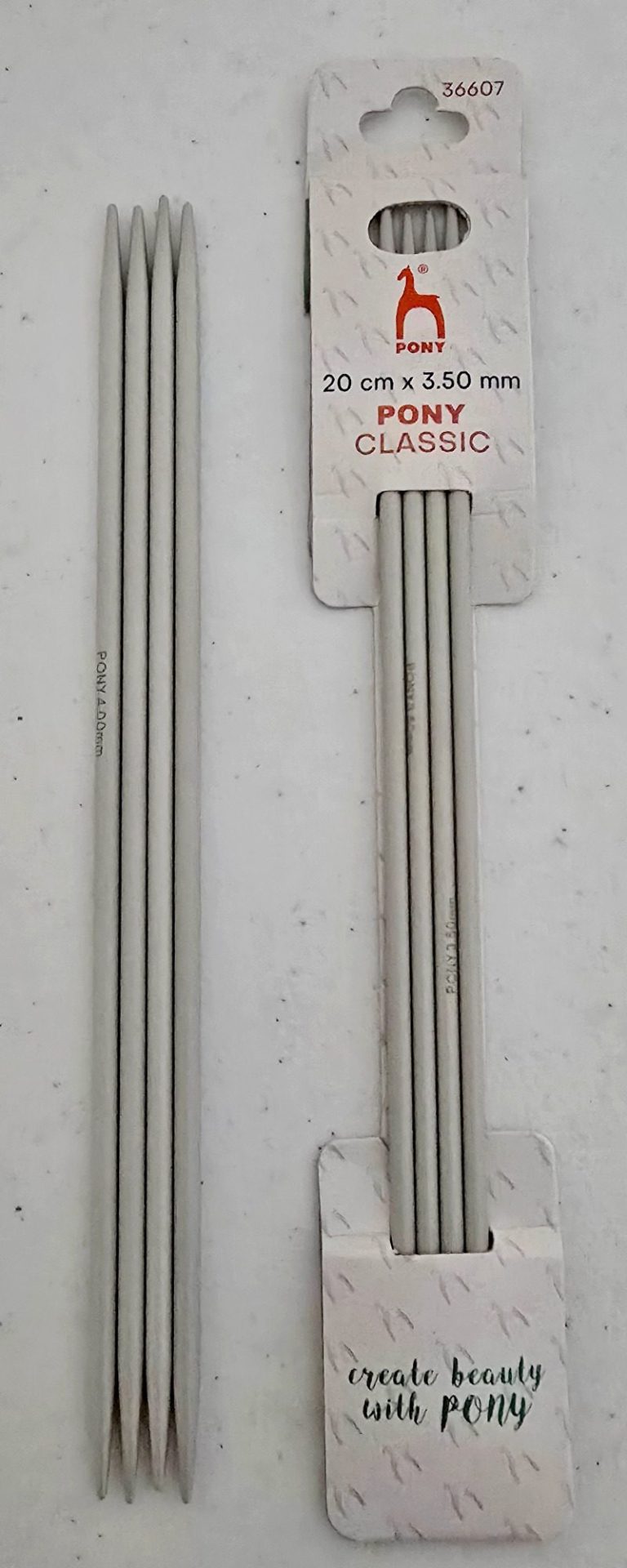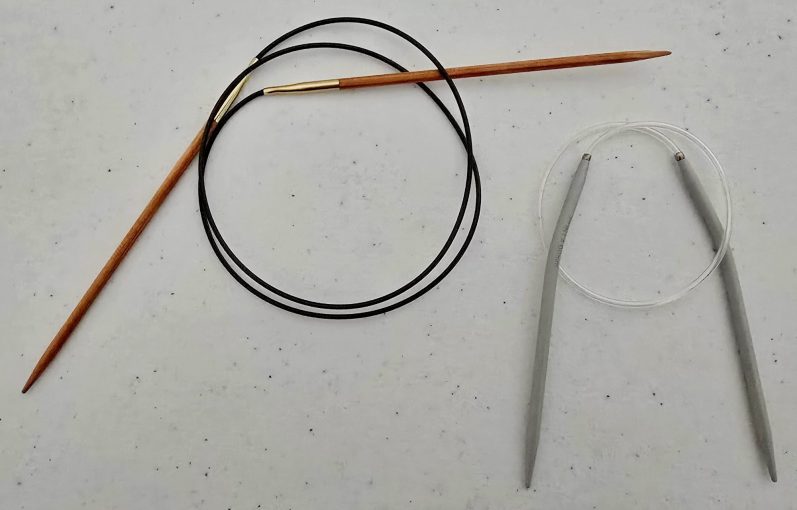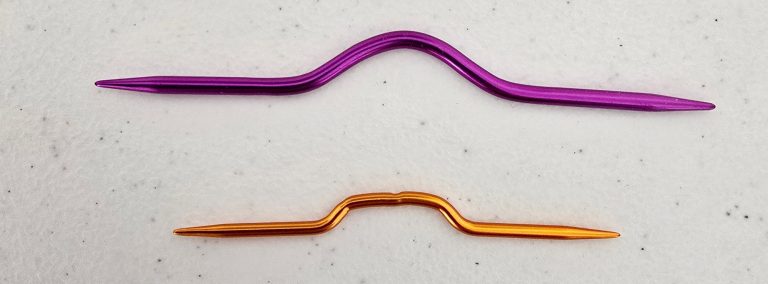TOOLS 101
NEEDLES
I’m sure you have seen knitting needles before.
But did you know they can be made of a variety of materials? The most common ones are made of metal or plastic. However, they can also be made of wood, bamboo, carbon fibre or glass.
Once you’ve been knitting for a while you will find your favourite material, so at this moment in time I would advise you to try different materials. Just go to the shop and explore the difference in weight and how they feel when you touch the needles. Metal, for example, will initially always be a bit cold to the touch, whereas bamboo and wood can be very soft and comforting.
And they come in different lengths as well, which I will cover for each type of needle.
Oh, it doesn’t end there. They also come in different sizes. Note that length and size are different measurements here. Not to worry, all will be explained.
For now, all you need to know about size is that it’s the thickness of the needles. See an example of different sizes here

Knitting. It’s the mystery of needles going back and forth, often accompanied by clicking noises, and wool miraculously turning into a ‘thing’ or ‘garment’.
This article is part of a series that will explain exactly what tools the witch or wizard uses to make this magic happen. They don’t mind, it’s not a secret.
In this article
This is a pretty long article. You can of course read it all in one go, if you want, but if you are looking for specific information, just jump to the section you need. Here are the space portals (also known as 'links') you can use.
Needles - sizes and materials
Let’s start with the most common type: the single pointed needle. They look like this:

Single pointed needles
The most common length for single pointed needles is 35cm long, but they can be anything between 18cm and 40cm.
Things to consider when deciding on how long you want your knitting needles to be are:
- are the needles you intend to buy comfortable to use?
I personally have a preference for the longer needles, but you might prefer shorter ones. You’ll have to try them and decide for yourself. - how big is your project?
If you start knitting a blanket or an adult’s sweater, shorter needles may not be the right choice. You can only comfortably fit so many stitches on one needle. With single pointed needles all of your stitches will be on one needle regularly and you’ll have to be able to hold that needle comfortably.
As mentioned before, the material is entirely up to you. If you’re not sure, just go with the metal ones. They are readily available and they are cheap.
The name says it: these needles have points on both ends. They look like this:
Double pointed needles

If you have ever seen anyone knit, you may have seen them make socks. It’s the most common use of DPNs (as they are also referred to). You use 4 needles, and 3 will have stitches on them.
It looks quite daunting when you’re just starting to knit (trust me, I’ve been there), but there is a logic to it. Once you try using double pointed needles you will very likely find it’s really not that difficult.
The materials used are the same as for single pointed needles with a few additions, such as hardwood and aluminium.
Double pointed needles can be quite short, for example just over 15cm. It is all you would need for a standard pair of socks. You wouldn’t want the needles to be too long, because they would just get in each other’s (and your) way.
However, they are available up to a length of 20cm. It all depends on what you are making with them.
You will find that most knitting patterns that require DPNs do state the ideal length for the needles. If you follow the pattern’s advice you will be just fine.
Circular needles have straight needles at each end with a length of ‘cable’ in between. They look like this:

Circular needles
Like double pointed needles, you can knit ‘in the round’ with these. So, if you don’t get along with double pointed needles, you can absolutely knit socks with a small circular needle. Whatever works for you!
But you can also think bigger. Because circular needles can be as short as 22 cm or as long as 1.5 metres, you can knit literally anything in the round on them. A top or a dress without seams? No problem!
Again, the materials for the needles (so not the ‘cable’ in between) are similar to single pointed needles. That ‘cable’ is usually made of plastic.
Now, you don’t have to work in the round with circular needles. If you want to make a blanket for a double bed (just think how big that has to be), you will need quite long knitting needles to fit all the stitches on. Circular needles are very likely what you’d need.
Just because they are called ‘circular’ doesn’t mean you can’t just knit back and forth as you’d do with single pointed needles.
These small bendy things are not used for everyday knitting, but they are needles, so I will cover them here.
They look like this:

Cable needles
As you’d expect, it’s in the name: these tiny double pointed needles are used when you have cables in your work.
This is what a knitted cable can look like:

I said ‘can’, because there are so many varieties of cable. But I digress…cables are for later.
Cable needles can be made of plastic, metal or wood/bamboo.
I have just shown you some with a kink or bend in them, but they are available straight as well. I would not recommend those, though. Cable needles are used to temporarily hold some of the stitches, allowing you to move those stitches to another position in your work. Straight ones might slip, which means you end up with stitches that are not on any needle at all. There we are: the dreaded dropped stitches.
The cable needles with a bend in them are a bit more secure in that respect.
Cable needles are short. You wouldn’t want to have a long needle dangling in front or at the back of your work. It would seriously hamper your movements. They are usually around the 10cm mark.
The size of the needle is much more important, because that depends on the size of your main needles and the work you are doing. However, that also falls outside of the scope of this article. We will get back to that once it becomes relevant.
There you have it, the short and narrow on knitting needles.
I know, it can still be confusing, but don’t worry. Like most knitters I will get you started with single pointed needles. The other types are for later.
Time to move on to the next chapter in the Wizard’s or Witches Guide to Knitting Magic: Yarn.
Off you go!
